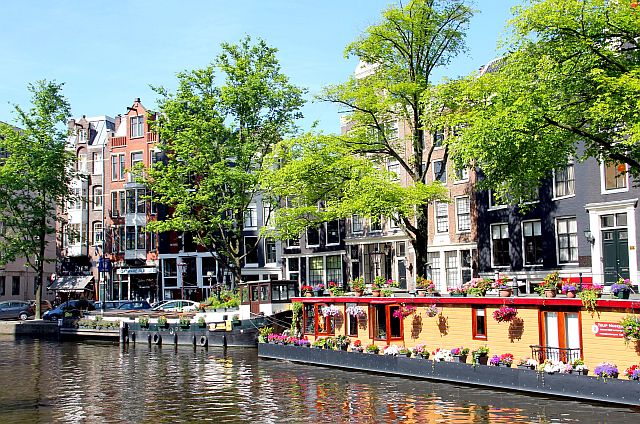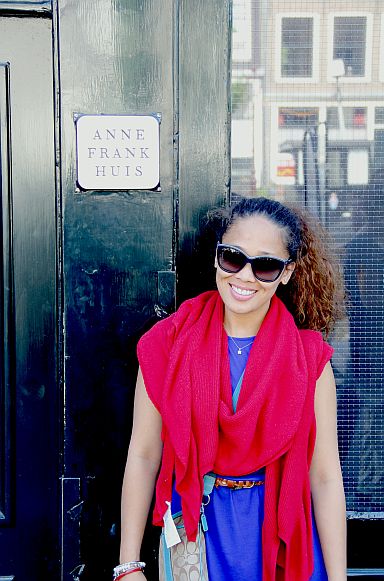
A house boat in an Amsterdam canal
AMSTERDAM has built a reputation as a wild, anything goes kind of city. It’s a city where all kinds of drugs are legal, and so is prostitution. The city’s famous cannabis coffeeshops draw over 5 million visitors a year, while the red light district attracts curious visitors who sometimes sneak a peak though the windows. But to peg Amsterdam as the Sin City of Europe would be unfair.
While some people visit for reasons that are usually outlawed in their own home countries, there’s much more to see than that. Amsterdam is a historic city of artists and museums, beautiful open spaces and canals, tulip shops, and the famed Anne Frank house.
Amsterdam is the capital city of the Netherlands, and at 1.6 million people in the metropolitan area, it is also the most populated city in the country.
The city was given its name because it sits on the Amstel River. The city holds over 100km of canals including a center ring section that divides the city into 90 separate islands, which are linked together by more than 1,200 bridges. It’s no wonder why the city is compared to Venice, Italy and its famous canals.
While Venice has slightly more islands, Amsterdam has nearly three times as many bridges. Both offer unique opportunities to walk and get lost in the maze of canals and discover the cities.
We were able to spend two full days exploring Amsterdam.
We arrived early in the morning and as we strolled through the canals, it became obvious that the city is known more for its nightlife rather than its early mornings.
Just walking around it felt like we were late to a party, with most areas closed and litter from the night before still on the ground.

Anna at the door of Anne Frank’s house
Anna and I continued to walk throughout the city and over the next few hours we could see the city shaking off its hangover and coming back to life.
The streets started to fill up and shops were opening. It was a sunny day and everyone seemed to be enjoying the weather.
On our first day of the visit, it just happened to be what would have been the 85th birthday of Anne Frank, the famous diarist and Holocaust victim. I remember reading her “The Diary of a Young Girl” when I was in school, giving a detailed and horrifying account of the Nazi occupation and her family’s eventual doom as they were removed from hiding and sent to the Bergen-Belsen concentration camp. I have haven’t any of the many plays or movies based upon her writing, so it had only been up to my imagination to picture the building where her family went into hiding.
As much as we wanted to see what’s inside the house, the tickets had been sold out for weeks and even the line of ticket holders stretched several city blocks. But after our visit when I returned to the ship, I downloaded Anne Frank’s diary and reread it, this time knowing what the area looked like.
Now I have to be honest that during this visit, our curiosity got the best of us. Amsterdam is quite known for the De Wallen district or the red light district, where prostitution is legal and the alleys contain hundreds of small windows where the “goods” are on display. We chose to briefly walk through a small area in the day, thinking we could see it when it was closed, avoiding everything at its full glory. Well, even during this time we got more than we wanted to see… (For the record, neither Anna nor I support prostitution, legal or not, and find the human trafficking behind it to be horrific.)
The other darker side of Amsterdam that was even more obvious was the prevalence of drugs on every street. Amsterdam has chosen to be liberal in their allowance of drug use in the city. Buying drugs in the street is still considered illegal, but there are hundreds of stores and coffeeshops that sell drugs legally and allow their use in plain sight. This became more and more apparent as the day wore on and the cafes started to fill up and the smoke started filling the air.

A coffee shop named The Jolly Joker, where cannabis can be purchased
Back to more traditional culture, Amsterdam has served as home to famous artists throughout history. The painters Vincent van Gogh and Rembrandt both made their homes in the city at one point in their lives.
Anna and I visited the home of Rembrandt, which has been turned into a museum. In this beautiful brick building fronting the canal Rembrandt lived and worked over 450 years ago. Here, you realize that even Rembrandt fell on hard times due to living beyond his means, particularly with his obsession of buying other people’s art.
One interesting fact I learned at the museum was that Rembrandt oftentimes bid up his own work to fetch a higher selling price. The court ordered him to sell his huge art collection but unfortunately it brought in a disappointing amount and he was still forced to sell off his house and printing press.
Unfortunately, we weren’t able to visit the Van Gogh Museum, which is not too far from the inner part of the city. But we were able to visit much of the new and old city.
One building that drew our interest was the Waag building. I am fascinated to see how cities develop and transform generation after generation and this building is a perfect example. It started almost 600 years ago as part of the original city walls. Over the years it served as a guildhall, museum, fire station, weigh house, café, restaurant, and anatomical theater.
What exactly is an anatomical theater? Exactly as you might guess—a theater of the human anatomy! Five hundred years ago, they didn’t have the medical technology and resources that we do now. As a part of the learning process, humans were dissected for scientists to learn about the human anatomy.
One of these particular anatomy sessions at The Waag building was captured in Rembrandt’s painting “The Anatomy Lesson of Dr. Nicolaes Tulp.” Today the building is used for far less grotesque means; the Waag Society occupies the upper floors and a café and restaurant are housed in the ground floor.
Two other famous products of Amsterdam and the entire Holland region were clearly on display and available for purchase throughout the city: cheese and tulips.
Dutch cheese is famous around the world and you can usually find either Edam or Gouda cheeses in the grocery store. There are even entire stores devoted to Dutch cheeses.
The other famous Dutch export is the tulip. The tulip industry started in the Netherlands over 400 years ago when seeds from the Persian Empire were brought over and planted. Within a few decades the demand grew and grew and there was a tulip frenzy with the value skyrocketing so much that the bulbs were treated as a form of currency. While the origin of the flower was from Persia and the Ottoman Empire in what is now known as Turkey, the Dutch tulips are the most popular kind in the world.


